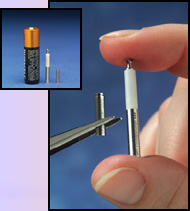
|
This bion, shown at right with the battery, is implanted to help sufferers of atrophied or dysfunctional muscles. The battery (above far right) is 100 times smaller than a AA battery. |
Miniature battery makes a big difference |
|
A new miniature battery is powering tiny, implantable devices that could help millions who suffer from a variety of neurological disorders, such as urinary-urge incontinence and stroke. The devices, called “bionic neurons” or bions®, are implanted near nerves, where they emit electrical micropulses that stimulate nearby muscles and nerves. The strength and frequency of the stimulation can be programmed from outside the body, and the tiny batteries can be recharged wirelessly with an electrical field. The entire bion system for implant is only about 1/35 the size of a standard AA battery and can be implanted using minimally invasive techniques. Competing systems for treating these kinds of muscular impairments require large batteries and invasive surgery to implant wires and electrical leads in the body. Feasibility trials are now under way on patients suffering from urinary-urge incontinence. This condition causes sufferers, mostly women, to leak substantial quantities of urine many times a day. The bion, currently in feasibility trials, comprises three integrated parts:
“The battery designed and engineered by Quallion is the smallest cylindrical, rechargeable battery ever made,” said Hisashi Tsukamoto, Chief Executive Officer of Quallion. “It provides a long-life power source that overcomes one of the primary hurdles in medical microelectronics.” Previous batteries for medical microelectronics are large, have short lives and are not rechargeable. Consequently, only a few implantable devices, such as cardiac pacemakers, have evolved for patient use. The key to the battery’s success is an advanced lithium-ion chemistry that provides a calendar life significantly greater than commercially available lithium batteries. Argonne has extensive experience in developing advanced battery chemistries with extended service life under the Department of Energy’s FreedomCAR and Vehicle Technologies Office, aimed at developing advanced batteries for hybrid electric vehicles. Silicon polymers were first studied by the organosilicon research group at the University of Wisconsin-Madison under the leadership of Professor Robert West. For the past few years, Argonne and the University of Wisconsin, working with Quallion, have actively pursued this chemistry and developed a new class of polymer electrolytes, made largely of silicon-oxygen chains, that exhibit extraordinary conductivity and safety properties. “This material has the highest conductivity ever reported for any polymer electrolyte and is non-flammable,” said Argonne’s Khalil Amine, co-inventor of the battery chemistry. “It is leading-edge battery chemistry that has enabled miniaturized batteries with the long lifetimes needed for medical devices.” Argonne and the University of Wisconsin are working with Quallion on a next-generation miniature battery using the polymer electrolyte chemistry, which developers anticipate will have a lifetime of 10 years or possibly more. Argonne’s polymer battery research is funded by Quallion under a grant from the National Institute of Standards and Technology, Advanced Technology Program. Argonne’s battery chemistry is available for licensing in selected fields of use. For more information, please contact David Baurac. |
